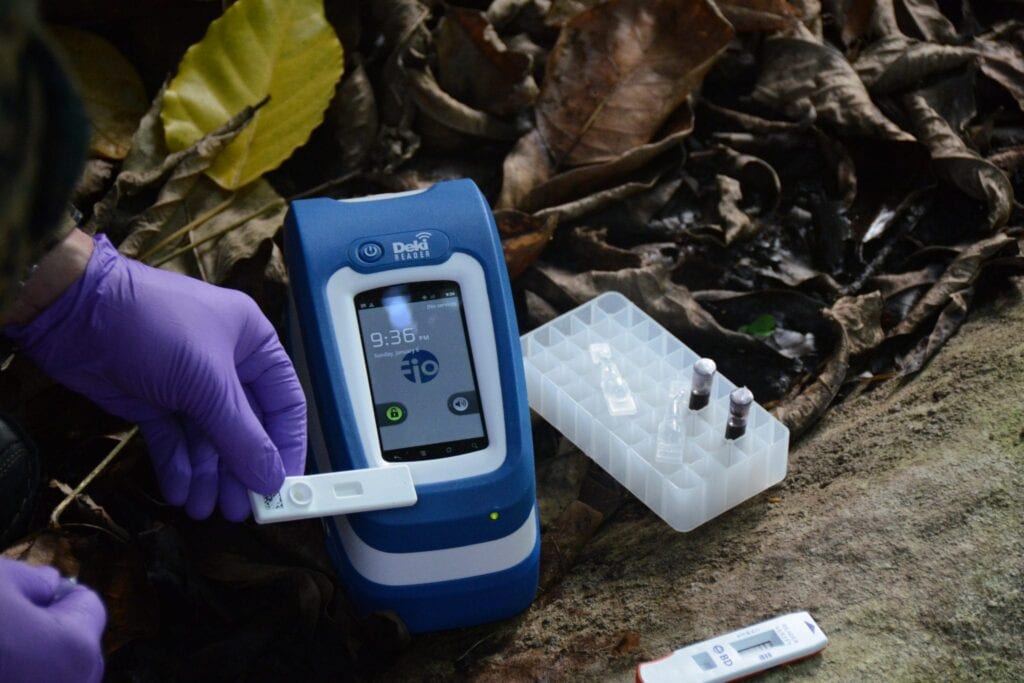
U.S. Naval Research Laboratory (NRL) scientists have spent the past two years helping the Defense Threat Reduction Agency (DTRA) better predict pending epidemics and regional disease outbreaks. This objective is at the heart of two linked programs at DTRA.
First, the 24 Month Diagnostic Challenge (.pdf) is a multi-agency program to identify and develop the diagnostic devices needed to make such biosurveillance a reality. In parallel, another DTRA program is developing a cloud database that analyzes the incoming data.
“The 24 Month Challenge is a model of government program management efficiency,” says Dr. Bradley Ringeisen the Lead Science and Technology Manager at DTRA for the 24 Month Challenge. “We were asked by ASD (Assistant Secretary of Defense for Nuclear, Chemical, and Biological Defense Programs) Andrew Weber and his office to screen the commercial sector for the best technology, develop new assays, and perform extensive analytical testing on the devices so that they could be further tested on real patients in a clinical research demonstration, all in two years!” The NRL team consists of Shawn Mulvaney, Lisa Fitzgerald, Leila Hamdan and Barry Spargo, from the Chemistry Division, and Nova Research, Inc. contractors Jaimee Compton, Nina Long, and Emily Petersen.
Within the 24 Month Challenge, the NRL team has validated and verified the capabilities of multiple diagnostic devices to best select technologies for deployment across the globe. “DTRA decided early on that utilizing a DoD laboratory like NRL was the right way to go,” added Ringeisen. “NRL has the expertise to screen the technology space, contract to the best performers and then work with the company to develop and test the best product for the government dollar. In every facet, NRL exceeded our expectations and delivered tested diagnostic devices on time that will now be shipped to Naval Medical Research Units on four continents for clinical testing.”
In the first phase of the program, the NRL team with tremendous support from the NRL Contracting Division solicited proposals for diagnostic technologies that met the core requirements-the ability to differentiate the causative agent of febrile illness and send the diagnostic data to the cloud database. In total, thirteen diagnostic technologies were evaluated by three laboratories, with the NRL team examining six technologies that ranged in complexity from PCR thermocyclers to paper-based diagnostics. Evaluations over the past year whittled down the original list to four technologies, enabling NRL to engage three companies with cooperative research agreements to develop prototype technologies that more directly address the program’s requirements.
“NRL has developed a relationship with two companies, InBIOS International, Inc. and ChemBio Diagnostics Systems, Inc. that make lateral flow immunoassay strips or LFIs. For reference, the best known example of a LFI is the home pregnancy test,” said the NRL principal investigator Shawn Mulvaney. “We then challenged these companies to make their new LFIs capable of detecting the causative agents for malaria, dengue fever, melioidosis, and the plague using only a blood sample obtained from a finger prick. These are some of the most concerning diseases found in theater, particularly for our troops stationed in tropical climates.”
As one can imagine, a program called the “24 Month Program” requires speed and precision by all participants. “Indeed, we not only gave the companies a real challenge with multiplexed detection, we then asked them to do it in less than six months,” added Mulvaney. Those companies recently delivered their goods and, starting on November 4, 2013, the NRL team has performed analytical testing for sensitivity and stability, performing almost 2400 LFI tests. In parallel, NRL has coordinated for live-agent testing to be conducted by the Naval Medical Research Center and the Walter Reed Army Institute of Research expending another 600 LFIs. “In a six-week period we have obtained an excellent sense of how these LFIs perform, such as how sensitive and accurate they can be and if they will work in the heat and humidity of the tropics,” explained NRL’s Lisa Fitzgerald.
However, the LFI tests only meet half of the 24 Month Challenge’s requirements. NRL has also partnered with Fio Corporation to use the Deki Reader for test analysis and communications. The Deki Reader is a portable unit that is built around an android smart phone. It can use the camera feature to take pictures of every LFI test, the software to guide the user, analyze the outcomes, and phone features to upload the data over the cellular network.
“This is a clever solution to multiple challenges,” explained Mulvaney. “LFI tests are inexpensive and rugged, making them well suited for biosurveillance. Meanwhile the Deki Reader gives the program great flexibility. In a single device, one can read a variety of LFI tests with standardized detection and analysis. And it’s a cell phone, so uplink is possible across the globe. Most importantly, the Deki Reader software walks the user though the test protocol thereby greatly enhancing the likelihood of accurate results.”
Based on the strong analytical data obtained during NRL’s testing, the three technologies are set for field-trials in South America, Africa, and Southeast Asia. NRL has been coordinating with the OCONUS testing teams and will remain active for support and troubleshooting. Keeping with this program’s rapid pace, the OCONUS labs are beginning their testing in January 2014.
Article courtesy of U.S. Naval Research Laboratory, adapted.


